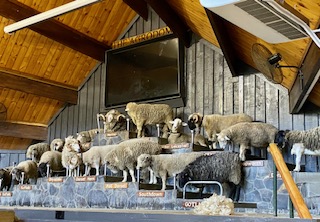We had another beautiful day, which everyone has marveled at. There has been a lot of rain in this part of New Zealand recently, making it extremely green. Today was expected to be in the high 60’s which is perfect.
Our first stop today was to the Agrodome to experience the many aspects of New Zealand’s sheep industry. This modern facility welcomed a couple hundred visitors who had a marvelous time seeing the many species of sheep. Merino sheep are the most sought-after and one of the most difficult to shear. They need a shearing at least three times a year because their wool is so fine and thick. However, their skin is very wrinkled, making it more of a challenge to remove the coat without hurting the sheep. Also, the horns are quite big and not easy to maneuver. I took pictures of the many types of sheep and they are all adorable with different qualities of wool. One even sheds its wool all by itself, without shearing!
The sheep were all lined up on either side of the auditorium and when called upon, they ran onto their step. Obviously, these sheep know the game and performed beautifully. The MC was great, very funny, and a pro at getting the audience involved. At the same time, she gave us a lot of information about how important the sheep industry is to New Zealand, both for the wool and the lamb they provide to the whole world.
Our next stop was to Te Puia, run by New Zealand’s indigenous Maori tribes. This park is home to New Zealand’s largest geyser, boiling mud pools, and silica terraces, the mineral deposits from the shooting water. The facility is divided into many areas. There is a Kiwi House, where kiwi birds, one of the three flightless birds, including the ostrich and emu, that are a part of New Zealand’s and Australia’s unique wildlife. There are habitats housing kiwis but they were very difficult to see within the enclosures.
From there, we walked to the bubbling mud pools and geyser area. The earth’s magma is not very deep in this volcanic area. There are many areas that release steam into the sky, with an actual geyser about every 45 minutes. These geysers can shoot water as high as 50′. We got there at the perfect time to see both the bubbling mud and a geyser.
We returned to our hotel in the early afternoon, leaving time for Jim to get in a 9-hole round of golf with one of the other guys in our group (from Houston), while I went to a local spa to enjoy their naturally hot mud baths and mineral water pools. This spa is similar to the Balneario (hot springs) we enjoy in San Juan Cosala, near Ajijic, where we have enjoyed the therapeutic hot water pools.
The day was still not over. In the evening, we explored the ancient culture of the Maori by experiencing the Haka (war dance), sharing a very special Hangi dinner (roasted meats and vegetables cooked underground with hot stones) in their Wharenui (ancestral meeting house), and a presentation of their stories through song and dance. The Maori culture has had a resurgence by teaching their language in the schools and having all signs throughout the country in both English and Maori. The food was plentiful, the tattooed “soldiers” showed their bravado and the final presentation of their storytelling was unique. We then walked around the grounds and were able to see glowworms again, this time in the wild, not in caves. It was a long and tiring day but very informative. We were definitely going to sleep well tonight! Tomorrow


